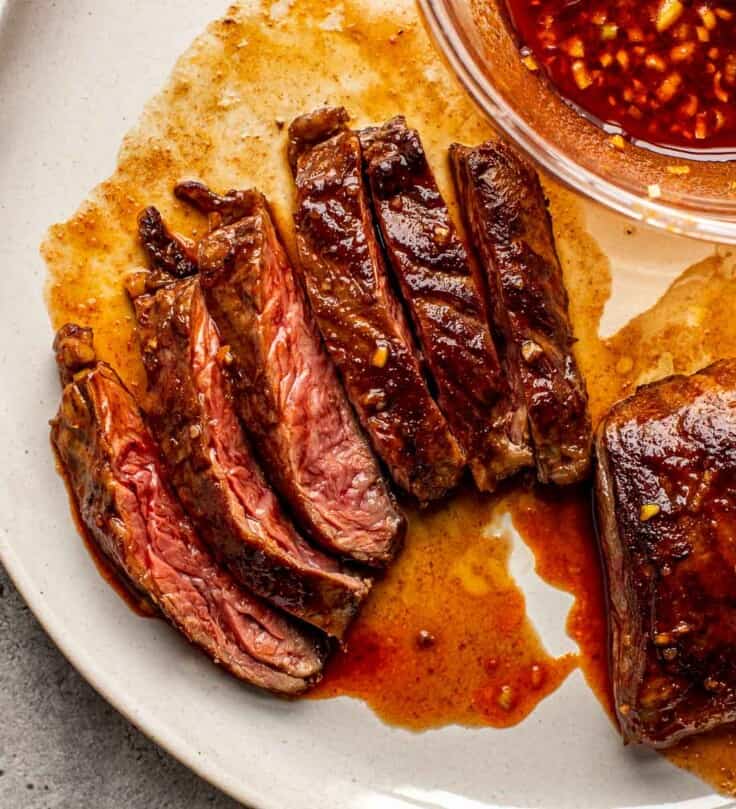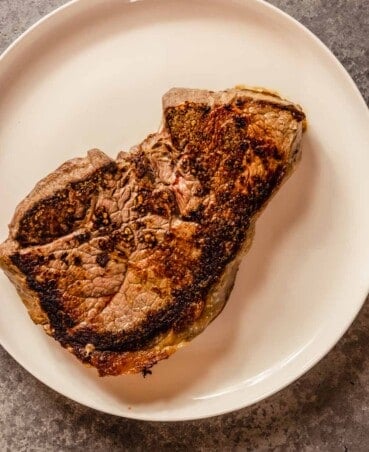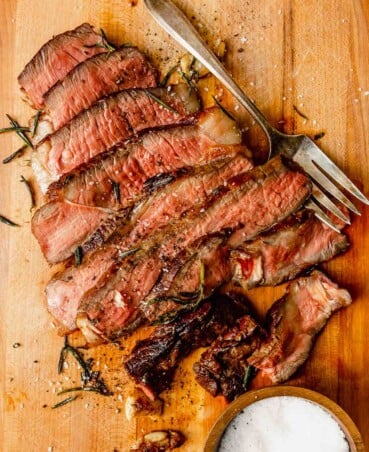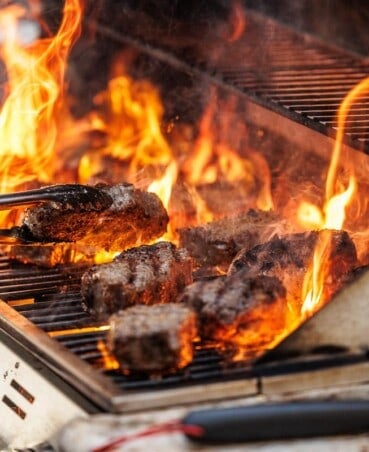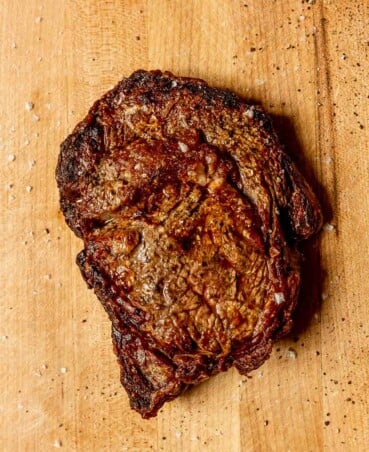Skirt steak is one of the quickest and easiest cuts of beef to cook! It’s a versatile cut that can be cooked on the stove top, grilled, and even broiled. It takes well to marinating but is also beefy enough to be simply seasoned with salt and pepper. We’ll cover the 6 best ways to cook skirt steak, plus share some of our favorite skirt steak recipes!
What is a Skirt Steak?
Skirt steak is a thin cut of beef that long and ribbon-like. It’s a nicely marbled, full-flavored cut form the underside of the cow.
When cut against the grain, the pleated cut is ultra-tender. Skirt steak is a quick-cooking cut of steak and it preferred for fajitas, salads, steak tacos, steak and eggs, and more.
Seasoning Skirt Steak
When you buy quality meat, you don’t need to complicate the seasoning. When in doubt, give each side of the steak a heavy dose of kosher salt and black pepper.
Dried herbs such as rosemary, thyme and oregano, or spices like red pepper flakes, fennel seeds, paprika and coriander are all great options as well.
Because skirt steak if so beefy in flavor, it doesn’t need a marinade. However, because of its loose grain structure, it actually responds well to a marinade (unlike most cuts of steak), and soaks up flavors in just an hour. We love to marinade skirt steak in chimichurri or our bright triple herb marinade.
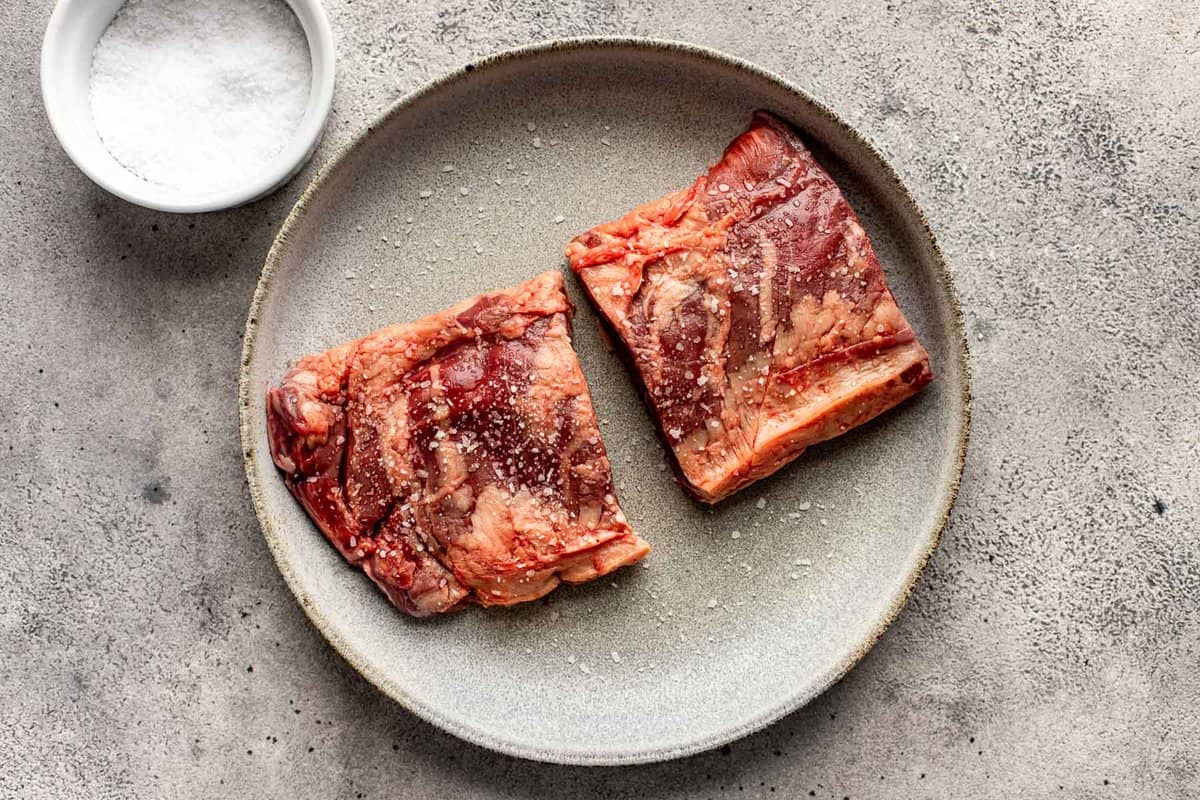
What to Look for When Buying Skirt Steak
There are two types of skirt steak cuts—the inside skirt and outside skirt. These two skirt steak cuts come from the underside of the cow just below the rib section and have very different textures.
The best cut of skirt steak is the outside skirt steak—make sure to ask your butcher for this cut. The inside skirt steak if chewy whereas the outside skirt is nice and tender (especially when cut against the grain).
Since the outside skirt steak is so sought after, it can be hard to find. So call ahead and reserve it, if you can.
Pro tip: seek out angus beef whenever you can. It guarantees you’ll get a quality, consistent steak every time. Not sure what Angus beef is? Check out this article where we break down the grades of beef and what they means.
Cook Steak By Temperature
The best way to ensure your steak is cooked to your liking is to monitor the internal temperature using an instant-read thermometer (this is our favorite thermometer).
Skirt steak should be removed from the heating element when it temps 5 degrees BELOW your desired doneness. Dense meat retains heat better, which causes internal temperatures to continue to rise as it rests off-heat. This is called carry over cooking, so if you want perfectly cooked meat, give it a short rest and keep an eye on that temp!
We should note, the USDA recommends cooking any cut of beef to an internal temperature of 145ºF.
Temperature Doneness Table
| Doneness | Pull from heat at | After resting temp should be |
|---|---|---|
| Rare | 120ºF (49ºC) | 125ºF (52ºC) |
| Medium-Rare | 125ºF (52ºC) | 130ºF (54ºC) |
| Medium | 135ºF (57ºC) | 140ºF (60ºC) |
| Medium-Well | 145ºF (63ºC) USDA recommended temp | 150ºF (65ºC) |
| Well-Done | 155ºF (68ºC) | 160ºF (71ºC) |
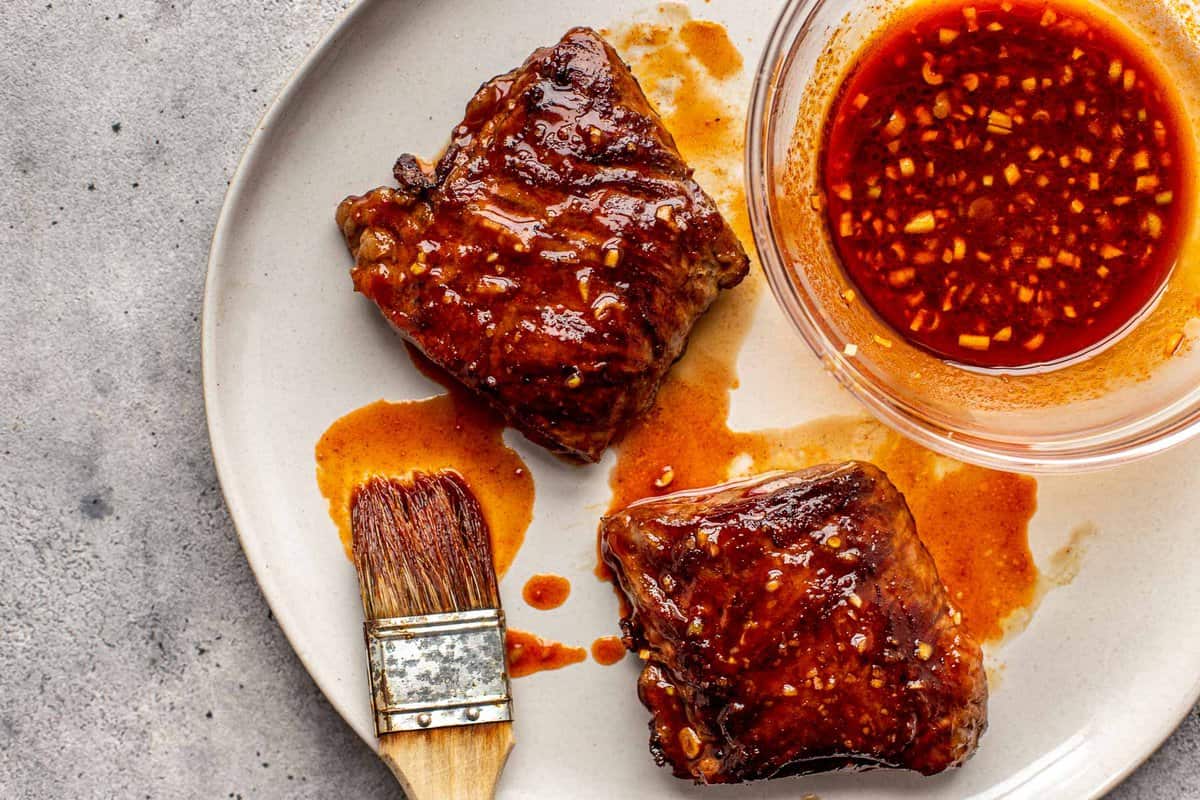
How to Cook Skirt Steak 6 Ways
Skirt steak is a great candidate for high-heat cooking because of its idea surface area-to-thickness ratio. It’s just thick enough to allow for deep, crisp browning without over-cooking on the inside.
The below timings and temperature is for a 1/2-inch thick skirt steak. One thing to note: we often recommend cooking steak to medium-rare (125ºF). Though we find the fatty yet fibrous skirt steak does best when cooked to medium (130ºF).
Before cooking the steak with any of the following methods, we recommend patting the steak dry with paper towels and seasoning well with kosher salt.
Stove Top
Cook seasoned steak in a preheated cast-iron skillet over medium-high heat for about 6 minutes total (3 minutes per side) for the perfect medium-rare, or 8 minutes total for medium.
Gas Grill
Preheat a gas grill on high. Turn all but the main burner off then cook steak over direct heat for about 3 minutes per side for medium-rare, or 4 minutes per side for medium.
Charcoal Grill
Open bottom vent of grill then prepare a chimney of charcoal. Dump the hot coals over one side of the grill, set the grate in place, then cook the seasoned steak over direct heat for about 3 minutes per side for medium-rare, or 4 minutes per side for medium.
Airfryer
Cook seasoned steak in the basket of an airfryer set to 400ºF. Cook for about 3 minutes per side for medium-rare or 4 minutes per side for medium.
Oven
Preheat an oven to 450ºF (232ºC) with a rimmed baking sheet set on the middle rack. Once the oven is adequately preheated, carefully remove the baking sheet from the oven using a kitchen towel or hot mitt. Brush sheet pan with some high-heat cooking oil and place steak on sheet. Return sheet to oven and cook 10 minutes for medium-rare, flipping steak halfway through. Cook for 12 minutes for medium.
Broiler
Heat broiler on your oven to high with rack set as close to heating element as possible. Broil steak on a baking sheet for 2–5 minutes per side until desired doneness is reached. (A larger time range is given as all broilers are different.)
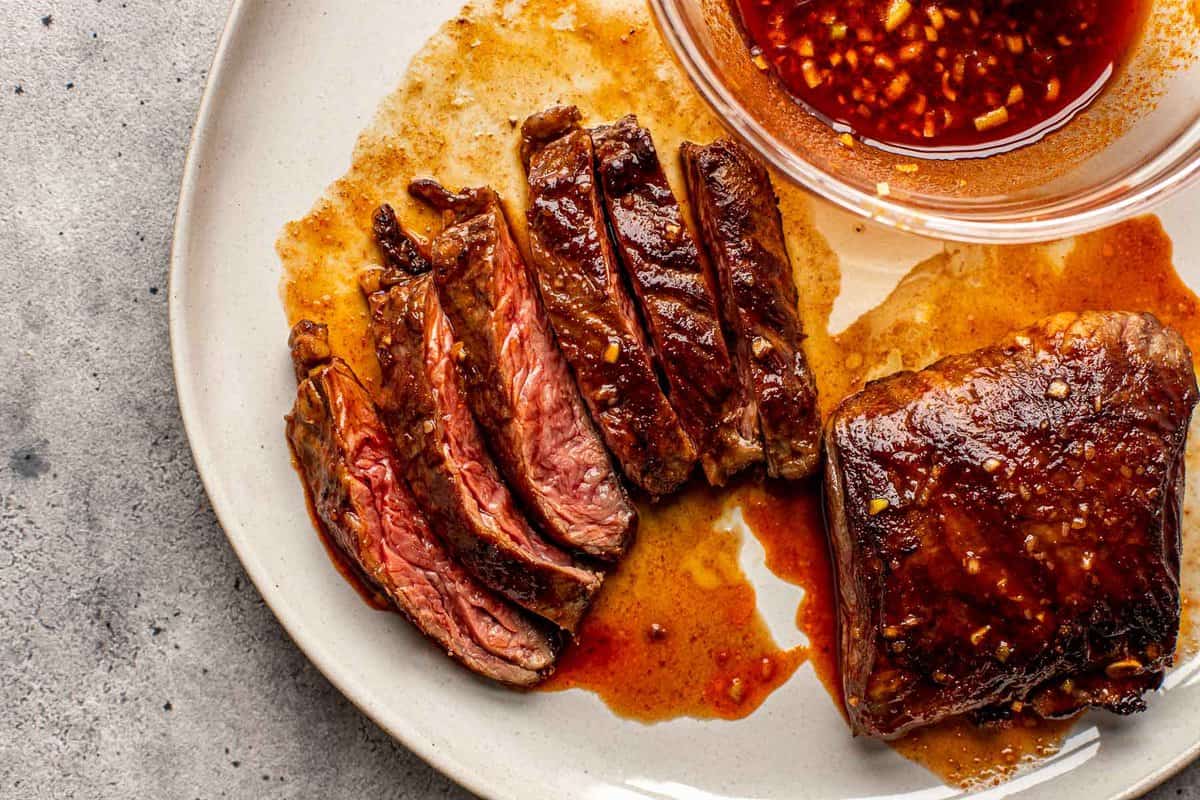
FAQ
No, hanger steak and skirt steak are two completely different cuts of beef. The skirt steak is found along the underside of the cow below the rib section. Hanger steak on the other hand, “hangs” between the ribs and tenderloin. Like the skirt steak, hanger steaks are known to be very beefy in flavor.
Skirt steak can also be labeled as “fajita steak” and “Philadelphia steak.”
Flank steak and skirt steak are often interchangeable in recipes (it is in our Steak and Eggs recipe). However, they are two completely different cuts of beef. Flank steak is also from the underside of the cow but is closer to the back of the cow and situated under the lean loin while skirt steak is closer to the front and found under the rib section.
Both cuts are beefy but flank steak is more lean and less juicy while skirt steak if juicier and fattier.
Both cuts are flat but a flank steak is usually much wider with the grain running the lengthwise, or the long way. A skirt steak is long and narrow with the grain running crosswise, the short way.
Flank steak has a happy spot right at medium doneness. It’s not overly tender when cooked to rare or medium-rare. It’s very tender and medium and becomes less tender the more it cooks past medium.
We love top sirloin! Here’s a great guide on how to cook top sirloin 4 ways!
How to Serve Skirt Steak
Here are a few way to serve our top sirloin steak recipe (below).
- One of our favorite ways to use skirt steak is to make Steak and Eggs! This meal will blow your mind.
- Serve with our chimichurri for a very classic skirt steak dinner. Pair it with a crispy fingerling potatoes.
- Thinly slice and serve over rice with our salsa verde and fresh cilantro.
- Use grilled skirt steak in place of flank steak in our Tacos al Carbón.
- Top with a slice or two of compound butter.
- Air fry the steak or grill the skirt steak and serve with our Garden Salad for a quick weeknight summer meal.
More Steak Cooking Guides
Dive into the world of steak with these steak cooking guides!
Learn how to cook Tri-Tip 6 different ways! Then learn how to cut tri-tip (it can be tricky!).
Splurge on a decadent cut cook a ribeye steak.
Dive into the world of top sirloin and learn how to cook top sirloin 4 different ways!
If you’ve got leftover steak, be sure you know the best way to reheat steak. Or check out this extensive list of leftover steak recipes.
How to Cook Skirt Steak Recipe
Description
Ingredients
- 1 (12-16 ounce) skirt steak
- kosher salt
- high-heat cooking oil, optional
Instructions
Stove top
- Preheat a large cast-iron skillet over medium-high for 5 minutes.
- Cut steak into two even pieces; pat dry with paper towels then season with 1 teaspoon salt.
- Add steak to skillet and cook until deeply browned on both sides and internal temperature reaches 130ºF, about 3½ minutes per side for medium.
Gas Grill
- Turn all burners to high, cover, and let grill preheat for about 15 minutes. Brush grill grate clean.
- Pat steak dry with paper towels, then season with 1 teaspoon salt. When ready to cook, keep primary burner on high and turn other burners off.
- Place steak over direct heat and cook until charred on both sides and internal temperature reaches 130ºF, about 3½ minutes per side for medium.
- Transfer steak to a clean plate, tent loosely with foil or parchment paper and let rest 5 minutes.
Charcoal Grill
- Open bottom vent completely. Light large chimney starter filled with charcoal briquettes (about 6 quarts). Once top of coals are partially covered with ash, pour evenly over half of grill. Set cooking grate in place, cover, and open lid vent completely. Let grill preheat, about 5 minutes. Brush grate clean.
- Pat steak dry with paper towels, then season with 1 teaspoon salt. Place steak over direct heat (coals) and cook until charred on both sides and internal temperature reaches 130ºF, about 3½ minutes per side for medium.
- Transfer steak to a clean plate, tent loosely with foil or parchment paper and let rest 5 minutes.
Airfryer
- Preheat airfryer to 400ºF (204ºC).
- Cut steak into two even pieces; pat dry with paper towels then brush both side with oil and season with 1 teaspoon salt.
- Place steak in a single layer in air fryer basket and cook until internal temperature reaches 130ºF, about 6 minutes total, flipping halfway through.
- Transfer steak to a clean plate, tent loosely with foil or parchment paper and let rest 5 minutes.
Oven
- Preheat an oven to 450ºF (232ºC) with a rimmed baking sheet set on the middle rack.
- Pat steak dry with paper towels, then season with 1 teaspoon salt.
- Carefully remove baking sheet from oven using a kitchen towel or hot mitt. Brush sheet pan with high-heat cooking oil and place steak on sheet.
- Return sheet to oven and cook until browned on both sides and internal temperature reaches 130ºF for medium, about 5 minutes per side.
- Transfer steak to a clean plate, tent loosely with foil or parchment paper and let rest 5 minutes.
Broiler
- Heat broiler high with rack set as close to heating element as possible.
- Pat steak dry with paper towels, then season with 1 teaspoon salt.
- Place steak on rimmed baking sheet and broil until charred and internal temperature reaches 130ºF for medium, 2–5 minutes per side.
- Transfer steak to a clean plate, tent loosely with foil or parchment paper and let rest 5 minutes.
Notes
Nutrition
Photography by Megan McKeehan.

Photography by Megan McKeehan.
